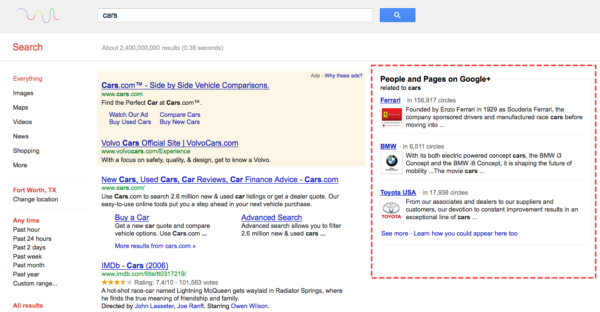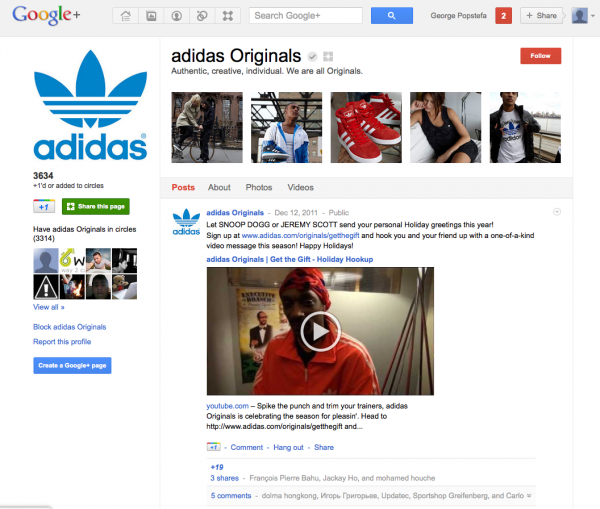A Google+ Primer For Retail Brands
In the last several months, there have been hundreds of articles written about Google+, its influence on the search engine marketing industry, discussing how marketers should be protecting against it or preparing to utilize it in the future. Due to this influx of Google+ publicity, our team has received dozens of inquiries from clients asking […]
In the last several months, there have been hundreds of articles written about Google+, its influence on the search engine marketing industry, discussing how marketers should be protecting against it or preparing to utilize it in the future. Due to this influx of Google+ publicity, our team has received dozens of inquiries from clients asking what all of this means.
As we prepare our clients for the changes that Google+ brings as part of the constant evolution that occurs across the search industry, we are once again reminded of the saying, “There is nothing permanent except change.” So, let’s get into this latest round of changes.
Before we dive into how to prevent and minimize traffic impact, we should first understand the current impact of Google Search Plus Your World. (SPYW)
CEO Larry Page announced recently that Google+ now boasts more than 90 million users worldwide, more than double the number of users it had in the previous quarter. Also, Page said “that engagement on the social networking site has been ‘growing tremendously’ as ‘over 60% of [users] engage daily, and over 80% weekly.’ ”
From an Adwords perspective, the left side of Google paid search results is now overwhelmingly replaced by Google+ relevant searches.
For advertisers that had been capitalizing by being in lower position to control cost and ROI, the table has turned completely. The new landscape dictates that you increase your maximum CPCs and get in the Top 3 or find alternative ways to make up your loss in revenue.
From an SEO perspective, many of the top results are now based on sites that users in your circle like rather than search relevance. Greg Finn recently addressed in great detail the good, the bad and the ugly truth about Google Plus.
Over the past couple of months, we have tried and tested every variation of Google+ avoidance and embracement. As all of us marketers are trying to wrangle the new parameters of Google+, I thought I’d share some of our findings.
Google+ And Your Brand Presence
I will assume that if you are reading this article, you already have a Google+ account for your website/brand and that you have Google+ button on your website.
With that assumption in place, the first thing you should is “pimp your Google+ presence.” In essence, I want you to treat it as your own website.
- Fill out your information and profile in as detailed and engaging way as possible
- Add pictures, videos and content specific to your brand
- Optimize your posts and descriptions as you would any other SEO page
- Grow your circles by integrating Google+ within your current social media network (Twitter, Facebook, etc)
Adidas Originals is a great example of Google+ brand page done the right way.
Here is an in-depth article by Neil Patel with additional details on pimping your presence.
Once you optimize your presence, make sure that you incorporate your Google+ button in all of your PPC ads. For a lot of our clients, we treat a Google+ interaction as a secondary conversion, similar to a newsletter sign up. Setting up a monthly budget specific to this is helpful in tracking and monetizing Google+.
You Have Lost Traffic From Your Top 3 Position Keywords… Now What?
If you are large brand with (nearly) unlimited budgets and high ROI, read no more. Just increase your maximum CPCs, and you are fine.
For the 99% of us that don’t fall into this category, here are some suggestions:
- Take advantage of ad enhancements – Google SPYW is getting more and more visual, and users are gravitating towards that vibrant content. Product Listing Ads (PLAs) and Product Extensions are two great ways to add significant, highly visual real estate to your PPC campaigns. This can help deliver incremental volume on non-brand keywords, and help minimize traffic loss on brand terms as the Google SERPs evolve.
- Look for alternatives – If your traffic starts to get impacted significantly, take some of your budget and get more competitive on other engines or invest in other programs. Display media, affiliates and Facebook ads are all areas that you can turn to make up some of your lost traffic.
- Leverage Google+ opportunities early – As Google releases more and more G+ related products and betas, the advertisers who get in early will see the biggest benefits. Don’t be afraid to take some risks, and adopt a “get there first” approach to SPYW.
From Matt McGee’s recent post on Two Google+ SEO Guides You Should Read to these findings we’ve gleaned ourselves, there are and will continue to be countless ways to learn, test and succeed within the new Google+ framework. And, the great thing about this constant change is that none of us are doing it alone. Let’s keep this conversational. You tell me what works for you, and I’ll do the same in this forum.
Google+ may present some unique changes, but most of us got into this industry for those very reasons – no two days are the same, and we have the ability to blaze new trails. I’d love to hear your feedback.
Opinions expressed in this article are those of the guest author and not necessarily Search Engine Land. Staff authors are listed here.
Related stories

